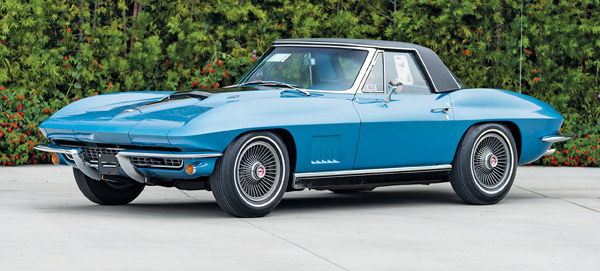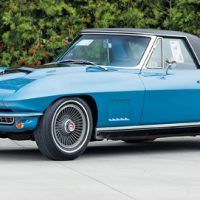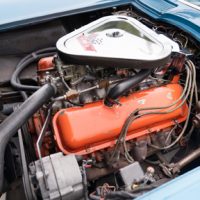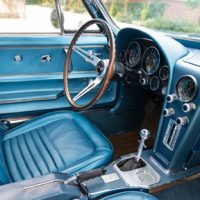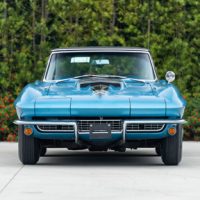- Top-of-the-line 427/435 convertible finished in Marina Blue over Bright Blue
- Highly optioned with desirable cast-aluminum bolt-on wheels, hard top, F41 suspension and off-road exhaust
- Well-documented chain of ownership dating back to 1967
- Bloomington Gold Certified, Survivor, Benchmark and NCRS Top Flight Award Winner
- Exceptionally well-preserved, unrestored example with original Protect-O-Plate. Among the finest examples known to exist.
SCM Analysis
Detailing
| Vehicle: | 1967 Chevrolet Corvette 427/435 Convertible |
| Years Produced: | 1967 |
| Number Produced: | 3,754 (of 22,940 1967 Corvettes) |
| Original List Price: | $5,622 |
| SCM Valuation: | $127,500 |
| Tune Up Cost: | $350 |
| Distributor Caps: | $25 |
| Chassis Number Location: | Plate on the passenger’s side dashboard lower frame |
| Engine Number Location: | Pad on the passenger’s front side of the engine block; on the top deck for the cylinder head |
| Club Info: | National Corvette Restorers Society (NCRS) |
| Website: | http://www.ncrs.org |
| Alternatives: | 1968–69 Chevrolet Corvette L71, 1968 Shelby GT500 KR, 1970–71 Plymouth ’Cuda (440 Six Pack) |
| Investment Grade: | A |
This car, Lot 23, sold for $246,400, including buyer’s premium, at Gooding & Company’s Scottsdale, AZ, auction on January 17, 2020.
The best year of the C2 Corvette wasn’t even supposed to happen.
The “Mako Shark” C3 generation of Corvettes was originally intended to be introduced for 1967. However, developmental issues delayed production to 1968 (indeed, the T-top coupes didn’t enter production until later in the model year, so the first C3s were solely convertibles).
As such, a few minor design changes were made — in addition to mechanical changes required for this first year of federal safety requirements, such as dual-master-cylinder brakes and collapsible steering columns. So the second-generation Corvette soldiered on for one more year.
For a car that wasn’t supposed to be, 1967 Corvettes — the final year of the C2 — are the most coveted of the generation. Of them, the 435-horsepower, triple 2-barrel induction, solid-lifter, 427-ci Mark IV big-block-powered examples (the first of three years the L71 engine configuration was available) are the top of the pecking order — always have been, always will be, even after we are forced into electric cars and sent to the gulag just for liking internal-combustion engines.
A shrinking market — but not for all of them
Our sister publication, American Car Collector, hosted a “Buy/Sell/Hold” market seminar at this year’s Barrett-Jackson Scottsdale auction. I was one of the panelists. This was two days before our featured car crossed the block.
One of my fellow panelists, Ken Lingenfelter, had the stock C2 Corvette as one of his picks as a car to sell.
His logic — backed with a lot of market data — is that the core market of enthusiasts is aging and putting more cars on the market. At the same time, younger enthusiasts are less interested in authentically restored concours lawn ornaments.
However, Lingenfelter sees more interest in modified/resto-mod examples. These cars appeal to collectors who want the cool look of an older Corvette — but one fitted with modern power and conveniences.
However, our subject car breaks those (and other) rules — and for good reasons.
Before discussing its current value, I’ll note that we have seen this car before, as it sold for $241,150 at Mecum’s 2012 Kissimmee auction (SCM# 6755197). Just on that result, one can make the argument that the car is staying flat in value.
This Corvette sold below Gooding’s $250,000 to $300,000 estimate, so it’s easy to say this sale proves Lingenfelter’s argument.
I suspect that the estimate was based more on high hopes than the real-world market — and our example was correctly sold.
This is the real deal
The joke among Corvette enthusiasts is that there are now at least twice the number of “original, numbers-matching” 435-horsepower C2s out there than were originally built.
For these pretender cars — and those with no provenance — Lingenfelter’s words about the C2 Corvette market are very prophetic.
Yet examples like our subject car, which has a known history and is in well-preserved original condition — and carries Bloomington Gold, Survivor and Benchmark accreditation — play by different rules.
With performance that puts it on a same level as exotics of the same era — sounds like the 2020 Corvette — the L71-powered ’Vettes will always be one of the most coveted Corvettes of all time.
The 21 L88-powered 1967 cars and the Z06 1963 Split-Window coupes are the only regular production C2 Corvettes to have greater value. The five 1963 Grand Sport Corvettes are special GM builds.
The power of provenance
While this is an original, cared-for car, one can easily argue that it’s not the ultimate example of an L71-powered 1967 Corvette.
While I like Marina Blue with Bright Blue interior, most would rather have red and/or black. On that same blue token, retaining its original Teal Blue vinyl soft top — in addition to the optional black vinyl hard top — is quite rare.
While 56k miles from new is quite low, there are examples out there with far less mileage.
What I think really made bidders chase this car was that it had seven verifiable owners from new.
Being a known entity from Day One secures it as a real-deal car.
The car’s original, unrestored — and good — condition is another big plus. Isn’t it nice to see that original cars in good condition are once again more valued than guano-encrusted barn finds?
Yet this car isn’t minty enough to seal it away in the garage. It’s okay to put a few miles on it every now and then.
All these factors show why someone stepped up — and wrote a big check — to become owner number eight. Correctly sold. ♦
(Introductory description courtesy of Gooding & Company.)
